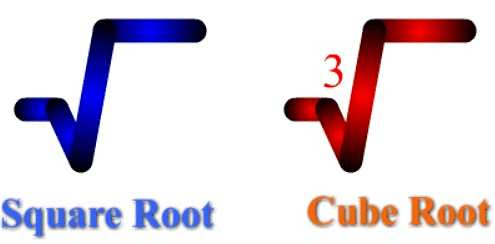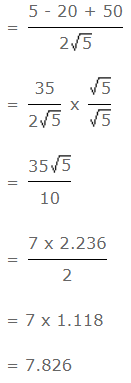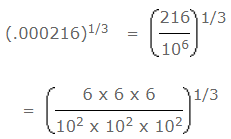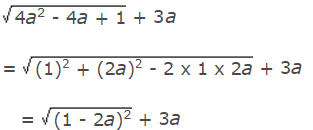Important Formulas: Square Roots and Cube Roots | Quantitative Aptitude for SSC CGL PDF Download

Square Root
If x2 = y, we say that the square root of y is x and we write √y = x.
Thus, √4 = 2, √9 = 3, √196 = 14.
Cube Root
The cube root of a given number x is the number whose cube is x.
We, denote the cube root of x by x.
Thus, 8 = 2 x 2 x 2 = 2, 343 = 7 x 7 x 7 = 7 etc.
Note:
- √xy = √x x √y

Examples
Example 1: (√625 x 14 x 11 is equal to: 11 √25 √196
(a) 5
(b) 6
(c) 8
(d) 11
Ans: (a)
Given Expression
Example 2: How many two-digit numbers satisfy this property. The last digit (unit's digit) of the square of the two-digit number is 8?
(a) 1
(b) 2
(c) 3
(d) None of these
Ans: (d)
A number ending in 8 can never be a perfect square.
Example 3: 
(a) 10
(b) 100
(c) 1000
(d) None of these
Ans: (b)
Then, 0.0169x = (1.3)2 = 1.69
⇒ x = 1.69/0.0169 = 100
Example 4: If √5 = 2.236;
Then the value of  is equal to:
is equal to:
(a) 5.59
(b) 7.826
(c) 8.944
(d) 10.062
Ans: (b)

Example 5: The square root of (7 + 3√5) (7 - 3√5) is
(a) 2
(b) 4
(c) √5
(d) 3√5
Ans: (a)
Example 6: What should come in place of both x in the equation:
(a) 12
(b) 14
(c) 144
(d) 196
Ans: (a)
= 8 x 6 x 3
= 144.
∴ x = √144 = 12.
Example 7: The cube root of .000216 is:
(a) .6
(b) .06
(c) 77
(d) 87
Ans: (b)
= 6/102
= 6/100
= 0.06
Example 8: The least perfect square, which is divisible by each of 21, 36 and 66 is:
(a) 213444
(b) 214344
(c) 214434
(d) 231444
Ans: (a)
L.C.M. of 21, 36, 66 = 2772.
Now, 2772 = 2 x 2 x 3 x 3 x 7 x 11
To make it a perfect square, it must be multiplied by 7 x 11.
So, required number = 22 x 32 x 72 x 112 = 213444.
Example 9: If a = 0.1039, then the value of  is:
is:
(a) 0.1039
(b) 0.2078
(c) 1.1039
(d) 2.1039
Ans: (c)
= (1 - 2a) + 3a
= (1 + a)
= (1 + 0.1039)
= 1.1039
Example 10: A group of students decided to collect as many paise from each member of group as is the number of members. If the total collection amounts to ₹ 59.29, the number of the member is the group is:
(a) 57
(b) 67
(c) 77
(d) 87
Ans: (c)
Money collected = (59.29 x 100) paise = 5929 paise.
Number of members = √5929 = 77.
|
317 videos|342 docs|156 tests
|
FAQs on Important Formulas: Square Roots and Cube Roots - Quantitative Aptitude for SSC CGL
| 1. What is a square root? |  |
| 2. What is a cube root? |  |
| 3. How can I find the square root of a number? |  |
| 4. How can I find the cube root of a number? |  |
| 5. What are some real-life applications of square roots and cube roots? |  |
















